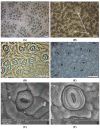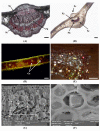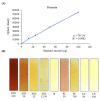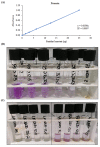Risk of Poisoning from Garden Plants: Misidentification between Laurel and Cherry Laurel
- PMID: 36355976
- PMCID: PMC9697506
- DOI: 10.3390/toxins14110726
Risk of Poisoning from Garden Plants: Misidentification between Laurel and Cherry Laurel
Abstract
The misidentification between edible and poisonous plants is an increasing problem because of the new trend to collect wild plants, especially by amateur collectors who do not have the botanical skills to distinguish between edible and toxic species. Moreover, morphologically similar species are sometimes responsible for accidental contamination or used in the intentional adulteration of products for human and animal consumption. Laurus nobilis L. (laurel) and Prunus laurocerasus L. (cherry laurel) are typical ornamental shrubs of the Mediterranean region. Laurel is considered a non-toxic plant, widely used as flavorings. Conversely, cherry laurel leaves, morphologically similar to those of laurel, contain toxic cyanogenic glycosides. Considering this, the aim of this study was to carry out an in-depth evaluation of laurel and cherry laurel leaves by using light and scanning electron microscopy coupled with three step phytochemical analyses (qualitative and quantitative colorimetric assays and liquid chromatography). This allowed to highlight the distinguishing features of plant species investigated features such as the venation pattern, presence/absence of nectaries, calcium oxalate crystals, secretory idioblasts, and cyanogenic glycosides. Concluding, this multidisciplinary approach can be useful for the identification of plants but also fragments or pruning residues containing cyanogenic glycosides, in quality control tests, intoxications, and criminal cases.
Keywords: Laurus nobilis; Prunus laurocerasus; edible plants; microscopy; phytochemistry; toxic plants.
Conflict of interest statement
The authors declare no conflict of interest.
Figures









Similar articles
-
Prunus spp. intoxication in ruminants: a case in a goat and diagnosis by identification of leaf fragments in rumen contents.J Vet Diagn Invest. 2004 Nov;16(6):593-9. doi: 10.1177/104063870401600620. J Vet Diagn Invest. 2004. PMID: 15586581
-
Phytopharmacological Possibilities of Bird Cherry Prunus padus L. and Prunus serotina L. Species and Their Bioactive Phytochemicals.Nutrients. 2020 Jul 2;12(7):1966. doi: 10.3390/nu12071966. Nutrients. 2020. PMID: 32630652 Free PMC article. Review.
-
The problem of misidentification between edible and poisonous wild plants: Reports from the Mediterranean area.Food Chem Toxicol. 2018 Sep;119:112-121. doi: 10.1016/j.fct.2018.04.066. Epub 2018 May 31. Food Chem Toxicol. 2018. PMID: 29753868
-
Comparative studies on structure of the floral nectaries and the abundance of nectar production of Prunus laurocerasus L.Protoplasma. 2019 Nov;256(6):1705-1726. doi: 10.1007/s00709-019-01412-z. Epub 2019 Jul 17. Protoplasma. 2019. PMID: 31312908 Free PMC article.
-
Toxic Garden and Landscaping Plants.Vet Clin North Am Equine Pract. 2024 Apr;40(1):61-76. doi: 10.1016/j.cveq.2023.11.002. Epub 2023 Dec 6. Vet Clin North Am Equine Pract. 2024. PMID: 38061967 Review.
Cited by
-
Emerging Plant Intoxications in Domestic Animals: A European Perspective.Toxins (Basel). 2023 Jul 4;15(7):442. doi: 10.3390/toxins15070442. Toxins (Basel). 2023. PMID: 37505711 Free PMC article. Review.
-
Thyridiumlauri sp. nov. (Thyridiaceae, Thyridiales): a new pathogenic fungal species of bay laurel from Italy.MycoKeys. 2024 Nov 15;110:211-236. doi: 10.3897/mycokeys.110.129228. eCollection 2024. MycoKeys. 2024. PMID: 39584031 Free PMC article.
-
The Dark Side of "Smart Drugs": Cognitive Enhancement vs. Clinical Concerns.Toxics. 2025 Mar 26;13(4):247. doi: 10.3390/toxics13040247. Toxics. 2025. PMID: 40278563 Free PMC article. Review.
-
Uncovering the poisonous aconitine containing plants in homemade herbal liquor using a convergent approach.Sci Rep. 2025 Aug 25;15(1):31286. doi: 10.1038/s41598-025-14764-9. Sci Rep. 2025. PMID: 40854923 Free PMC article.
References
-
- Cortinovis C., Caloni F. Plants Toxic to Farm and Companion Animals. In: Carlini C., Ligabue-Braun R., editors. Plant Toxins. Springer; Dordrecht, The Netherlands: 2017. pp. 107–134.
-
- Colombo M.L., Assisi F., Della Puppa T., Moro P., Sesana F.M., Bissoli M., Borghini R., Perego S., Galasso G., Banfi E., et al. Most commonly plant exposures and intoxications from outdoor toxic plants. J. Pharm. Sci. Res. 2010;2:417–425.
MeSH terms
Substances
LinkOut - more resources
Full Text Sources

